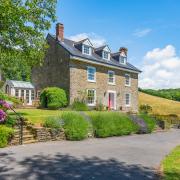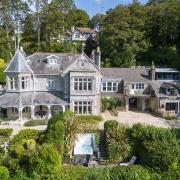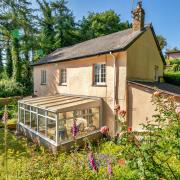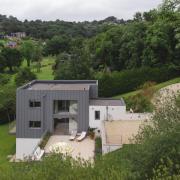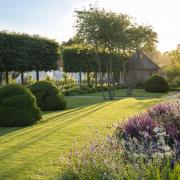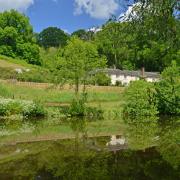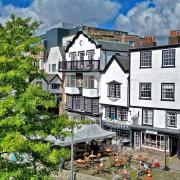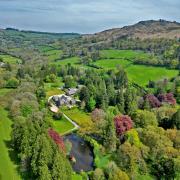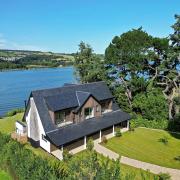As summer beckons, meadows across the land will soon reach their peak, buzzing with bees and splashed with colour.
Meadows hold a special place in our cultural history, and yet we have lost 97 per cent of UK meadowland since the 1930s, according to the charity Plantlife. But there is hope: Devon-based garden designer Hugo Bugg and his partner Charlotte Harris, who together make up the award-winning Harris Bugg Studio, have found more and more clients are putting meadows at the top of their wishlists. And no wonder. Hugo believes meadows are not only beautiful and biodiverse, they also help to make land more sustainable, by capturing carbon and improving water management.

But what exactly is a meadow? Hugo describes it as simply, ‘any place where grassland is allowed to flower and set seed and be a haven for wildlife’. Hugo and the Harris Bugg Studio team have had the privilege of helping clients create, renew and maintain meadows, from tiny urban plots to expansive country estates. Whatever the setting, the result is a landscape rich in nature.
Flowers, foliage and seedheads bring in bees, butterflies and other invertebrates, which in turn draws birds, amphibians and other larger creatures to take up residence.

When creating a meadow, the key is to start with the site. In rural locations, it is vital to support local wildlife by sticking to indigenous or naturalistic species, but the more urban the setting, the more exotic the range of flora can become.
Soil, aspect and location are the key factors Hugo considers when working on meadow projects, whether clients are trying to convert traditional lawns into something more wildlife-friendly, or turning former agricultural land into meadowland rich with native species.
Meadows tend to thrive on soil low in nutrients, so sometimes topsoil may need to be removed, which may be viable if you are having other works done that involve earthworks. A slower but more economic option is to sow yellow rattle (Rhinanthus minor), a semi-parasitic flower that helps to suppress the growth of grass over time, allowing other species space to thrive.
One of Hugo’s favourite approaches to meadow creation is to plant swathes of flowering bulbs through grassed areas. This helps to forge a visual link with more ornamental areas, but does not mean the meadow will look just like a herbaceous border.

‘This means you are getting a floral display, but at peak summer it is mainly grass; it’s a question of managing expectations of what the meadow looks like,’ he explains.
The key is making sure the selection of bulbs takes into account the length of the grass at flowering time of year, to ensure the flower heads are not obscured by the surrounding green. Bulbs must also be matched to the conditions: snowdrops thrive in the dappled shade of trees, while alliums enjoy full sun. In one garden designed for a client in Dorset, the heavy soil of the meadow proved the perfect setting for a carpet of moisture-loving blue and white camassias, with paths mown through to allow views to the grassland beyond. Bulbs will multiply by themselves given time, but making new plantings every year allows for tweaks to the scheme, adding in a flash of red from species tulip Tulipa sprengeri, or injecting drama in early summer with the pink blooms of the turk’s cap lily (Lilium martagon).
In other settings, the meadow planting palette can expand to include exotics.
Hugo says: ‘In a sunny location where you are looking for something with a bit more punch, brightness and seasonality, we can start to introduce exotics which bring a naturalistic feeling, but provide joy and drama.’

Harris Bugg’s RHS Chelsea garden for show sponsors M&G in 2021 showcased what was possible, bringing the aesthetic of the American prairie with the pinks and yellows of Echinacaeas and Solidagos set amongst the autumn tones of Amsonia (Amsonia illustris) and the delicate dainty grass, prairie dropseed (Sporobolus heterolepis).
Meadows can be productive spaces in more than one sense; as well as a hay harvest, meadows can also clothe the ground of productive orchards. In another project the Harris Bugg Studio created a meadow on a rural country estate, planting hundreds of spring-flowering bulbs, including fritillaries, crocuses and narcissi. This produced a beautiful display before the grass grew long, adding to the blossom on the crab apples, quinces and other fruit trees, as well as forging a visual link between the meadow and the wider landscape of open farmland.
The display continues through summer, too. ‘The sculptural forms of the fruit trees are captured in the morning sunlight, when the first golden hues fall across the seedheads of the grass in late summer, it’s very calming and very lovely,’ says Hugo.
Planning and creating a meadow may not bring instant results, but the process itself is both engaging and fun.
‘We love working with our clients over the years, engaging them in the process and enjoying seeing the variety of things that come up and trying something new every year,’ Hugo says.
And that enjoyment clearly rubs off on garden owners, too. ‘Clients just love spending time watching the wildlife. It’s really rewarding to see meadows becoming their hobby and passion.’
A MEADOW YEAR
Hugo’s planting choices for seasonal colour

Late winter
Eranthus hyemalis (winter aconite): One of the first flowers of the year. Plant in drifts alongside snowdrops
Galanthus nivalis (common snowdrop): Looks charming in clumps under dappled shade
Crocus tommasinianus (early crocus): These look fantastic naturalised with winter aconite

Spring
Narcissus lobularis (Lent lily daffodil): A wild daffodil perfect for naturalising, as the flowers produce seeds that self-sow
Tulipa sylvestris (wild tulip): This small and delicate species tulip naturalises well in shorter grass and full sun
Narcissus poeticus (pheasant’s eye daffodil): A later-flowering daffodil brilliant for naturalising in longer grass

Early summer
Camassia quamash (camas): A beautiful blue camassia that does well in meadows and moist ground
Camassia leichtlinii ‘Alba’ (Californian white-flowered quamash): Similar to quamash but with creamy-white flowers
Lilium martagon ‘Claude Shride’ (Turk’s cap lily): Deep rich crimson flowers that contrast with taller grasses. Dappled shade
Tulipa sprengeri (sprenger tulip): Species tulip with a delicate but vivid red flower from late May to early June

Autumn
Cyclamen hederifolium (ivy leaved cyclamen): Silver-lined dark green leaves and soft pink flowers
DEVON MEADOWS TO VISIT
Bellever Moor and Meadows, Postbridge, Dartmoor
Explore 72 hectares of nature reserve, including species-rich flood plain meadow.
devonwildlifetrust.org/nature-reserves/bellever-moor-and-meadows
Coronation Meadow, Dunsdon Nature Reserve, near Holsworthy
Traditionally managed wet rush meadow accessible via boardwalks
devonwildlifetrust.org/nature-reserves/dunsdon
Goat Walk Land, Topsham
Six-acre site near the River Exe meadows and orchards
goatwalklandtrust.org
Goren Farm, Stockland, Honiton
A small farm containing 50 acres of species-rich wildflower meadows set against the Blackdown Hills. Open via the National Garden Scheme throughout June and into July .
ngs.org.uk
RHS Garden Rosemoor, Great Torrington.
Wildflower meadows converted from grassland awash with spring-flowering bulbs .
rhs.org.uk/gardens/rosemoor




